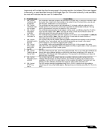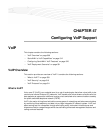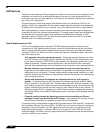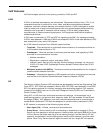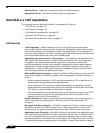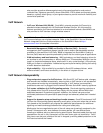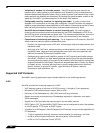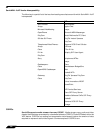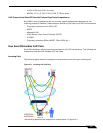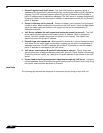
VoIP
511
SonicOS Enhanced 4.0 Administrator Guide
VoIP Protocols
VoIP technologies are built on two primary protocols, H.323 and SIP.
H.323
H.323 is a standard developed by the International Telecommunications Union (ITU). It’s a
comprehensive suite of protocols for voice, video, and data communications between
computers, terminals, network devices, and network services. H.323 is designed to enable
users to make point-to-point multimedia phone calls over connectionless packet-switching
networks such as private IP networks and the Internet. H.323 is widely supported by
manufacturers of video conferencing equipment, VoIP equipment and Internet telephony
software and devices.
H.323 uses a combination of TCP and UDP for signaling and ASN.1 for message encoding.
H.323v1 was released in 1996 and H.323v5 was released in 2003. As the older standard, H.323
was embraced by many early VoIP players.
An H.323 network consists of four different types of entities:
• Terminals - Client end points for multimedia communications. An example would be an
H.323 enabled Internet phone or PC.
• Gatekeepers - Performs services for call setup and tear down, and registering H.323
terminals for communications. Includes:
–
Address translation.
–
Registration, admission control, and status (RAS).
–
Internet Locator Service (ILS) also falls into this category (although it is not part of
H.323). ILS uses LDAP (Lightweight Directory Access Protocol) rather than H.323
messages.
• Multipoint control units (MCUs) - Conference control and data distribution for multipoint
communications between terminals.
• Gateways - Interoperation between H.323 networks and other communications services,
such as the circuit-switched Packet Switched Telephone Network (PSTN).
SIP
The Session Initiation Protocol (SIP) standard was developed by the Internet Engineering Task
Force (IETF). RFC 2543 was released in March 1999. RFC 3261 was released in June 2002.
SIP is a signaling protocol for initiating, managing and terminating sessions. SIP supports
‘presence’ and mobility and can run over User Datagram Protocol (UDP) and Transmission
Control Protocol (TCP).
Using SIP, a VoIP client can initiate and terminate call sessions, invite members into a
conferencing session, and perform other telephony tasks. SIP also enables Private Branch
Exchanges (PBXs), VoIP gateways, and other communications devices to communicate in
standardized collaboration. SIP was also designed to avoid the heavy overhead of H.323.
A SIP network is composed of the following logical entities:
• User Agent (UA) - Initiates, receives and terminates calls.
• Proxy Server - Acts on behalf of UA in forwarding or responding to requests. A Proxy
Server can fork requests to multiple servers. A back-to-back user agent (B2BUA) is a type
of Proxy Server that treats each leg of a call passing through it as two distinct SIP call
sessions: one between it and the calling phone and the other between it and the called
phone. Other Proxy Servers treat all legs of the same call as a single SIP call session.





